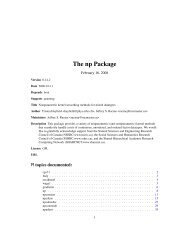The sfsmisc Package - NexTag Supports Open Source Initiatives
The sfsmisc Package - NexTag Supports Open Source Initiatives
The sfsmisc Package - NexTag Supports Open Source Initiatives
Create successful ePaper yourself
Turn your PDF publications into a flip-book with our unique Google optimized e-Paper software.
12 TA.plot<br />
Arguments<br />
lm.res<br />
fit<br />
res<br />
labels<br />
main<br />
xlab<br />
draw.smooth<br />
show.call<br />
show.2sigma<br />
lo.iter<br />
lo.cex<br />
Result of lm(..), aov(..), glm(..) or a similar object.<br />
fitted values; you probably want the default here.<br />
residuals to use. Default: Weighted ("Pearson") residuals if weights have been<br />
used for the model fit.<br />
strings to use as plotting symbols for each point. Default(NULL): extract observations’<br />
names or use its sequence number. Use, e.g., "*" to get simple *<br />
symbols.<br />
main title to plot. Default: sophisticated, resulting in something like "Tukey-<br />
Anscombe Plot of : y ˜x" constructed from lm.res $ call.<br />
x-axis label for plot.<br />
logical; if TRUE, draw a lowess smoother (with automatic smoothing fraction).<br />
logical; if TRUE, write the "call"ing syntax with which the fit was done.<br />
logical; if TRUE, draw horizontal lines at ±2σ where σ is mad(resid).<br />
positive integer, giving the number of lowess robustness iterations. <strong>The</strong> default<br />
depends on the model and is 0 for non Gaussian glm’s.<br />
character expansion ("cex") for lowess and other marginal texts.<br />
par0line a list of arguments (with reasonable defaults) to be passed to abline(.) when<br />
drawing the x-axis, i.e., the y = 0 line.<br />
parSmooth, parSigma<br />
each a list of arguments (with reasonable default) for drawing the smooth curve<br />
(if draw.smooth is true), or the horizontal sigma boundaries (if show.2sigma<br />
is true) respectively.<br />
... further graphical parameters are passed to n.plot(.).<br />
Side Effects<br />
<strong>The</strong> above mentioned plot is produced on the current graphic device.<br />
Author(s)<br />
See Also<br />
Martin Maechler, Seminar fuer Statistik, ETH Zurich, Switzerland; 〈maechler@stat.math.ethz.ch〉<br />
plot.lm which also does a QQ normal plot and more.<br />
Examples<br />
data(stackloss)<br />
TA.plot(lm(stack.loss ~ stack.x))<br />
example(airquality)<br />
summary(lmO

















